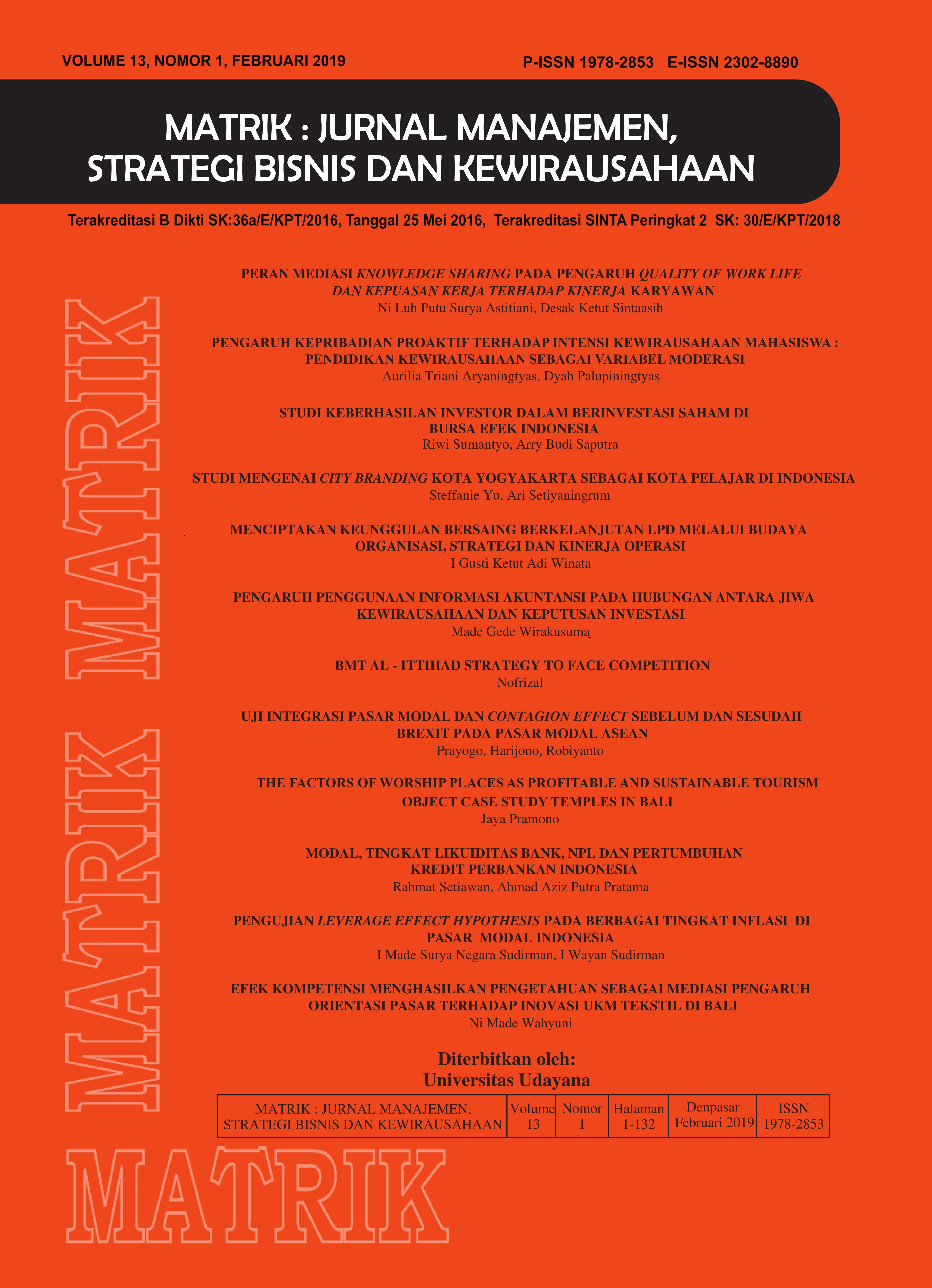PENGUJIAN LEVERAGE EFFECT HYPOTHESIS PADA BERBAGAI TINGKAT INFLASI DI PASAR MODAL INDONESIA
Abstract
Penelitian ini bertujuan untuk menguji dan menganalisis Leverage Effect Hypothesis pada berbagai tingkat inflasi di Bursa Efek Indonesia. Black (1976) dalam seminal paper-nya menyatakan Leverage Effect Hypothesis merupakan kondisi saat terjadi penurunan return saham akan diikuti oleh peningkatan volatilitas harga saham. Peningkatan volatilitas harga saham merupakan refleksi terjadinya peningkatan risiko saham tersebut. Risiko merupakan hal utama yang dipertimbangkan oleh investor dalam mengambil keputusan investasi saham selain return saham. Metode yang digunakan untuk menguji dan menganalisis Leverage Effect Hypothesis pada penelitian ini adalah TARCH dan EGARCH. Metode penentuan sampel dalam penelitian ini adalah purposive sampling, dimana periode penelitian dipilih berdasarkan tingkat inflasi. Terdapat tiga periode penelitian yaitu, periode tingkat inflasi rendah (Januari 2016- Agustus 2018), periode tingkat inflasi sedang (Januari 2012- Desember 2015), dan periode tingkat inflasi tinggi (Januari 2005 Desember 2006). Sumber data dalam penelitian ini adalah Bursa Efek Indonesia dan Bank Indonesia. Kebaruan penelitian ini adalah pada pengujian Leverage Effect Hypothesis yang dilakukan pada berbagai periode dengan tingkat inflasi yang berbeda. Perbedaan tingkat inflasi pada masing-masing periode yang memberikan tekanan yang berbeda terhadap risiko dalam investasi saham belum pernah diteliti selama ini. Hasil pengujian dan analisis menunjukkan terdapat Leverage Effect pada setiap periode pengujian. Terdapat kecenderungan semakin tinggi tingkat inflasi, Leverage Effect semakin besar. Hal ini menunjukkan semakin tinggi tingkat inflasi, semakin besar risiko yang dalam investasi saham. Temuan dalam penelitian ini memberikan kontribusi yang signifikan pada perluasan Leverage Effect Hypotesis dalam berbagai tingkat inflasi.
Kata Kunci: EGARCH, inflasi, leverage effect, risiko, TARCH
Downloads
References
Black, F. (1976) Studies of stock price volatility changes. Proceedings of the 1976 Meetings of the Business and Economics Statistics Section. American Statistical Association, 177-181.
Bollerslev, T. (1986) A Conditionally Heteroskedastic Time Series Model of Security Prices and Rates of Return Data. Review of Economics and Statistics, 59, 542-547.
Christie, A. (1982) Stocastic Behavior of Common Stock Variances: Value, Leverage, and Interest Rate Effects. Journal of Financial Economics, 31: 281-318.
Cagan, P. (1956) The Monetary Dynamics of Hyperinflation. In Friedman, Milton. Studies in the Quantity Theory of Money. Chicago: University of Chicago Press, 25-117.
Dickey, D. A., & Fuller, W. A. (1979) Distribution of Estimators for Autoregressive Time Series with a Unit Root. Journal of American Statistical Association, 74(366), 427-431.
Engle, R. F. (1982) Autoregressive Conditional Heteroskedasticity with Estimates of the Variance of UK Inflation. Econometrica, 50, 987-108.
Jones, C. P. & Jensen, G. (2016) Investment: Analysis and Management. 13th Edition. Wiley.
Banumathy, K. & Azhagaiah, R. (2015) Modeling Stock Market Volatility: Evidence From India. Managing Global Transitions, 13(1), 27-42.
Miller, M. & Modigliani, F. (1958) The Cost of Capital, Corporate Finance and Theory of Investment. The American Economic Review, 48(3), 261-297.
Nelson, D. B. (1991) Conditional Heterosceasticity in Asset Returns: A New Approach. Econometrica, 59, 347-370.
Nikmanesh, L., & Nor, A. H. S. M. (2016) Macroeconomic Determinant of Stock Market Volatility: An Empirical Study of Malaysia and Indonesia. Asian Academy of Management Journal, 21(1), 161-180.
Philips, P.C.B. & Perron, P. (1988) Testing for a Unit Root in Time Series Regression. Biometrika, 75(2), 347-370.
Schwert, W. (1989) Why Does Stock Market Volatility Change Over Time? The Journal of Finance, 5, 397-416.
Srinivasan, P. (2015) Modeling and Forcasting of Time-Varying Conditional Volatility of the Indian Stock Market. The IUP Journal of Financial Risk Management, XII(1), 49-64.
Triady, M. S., Kurniasari, R., Utami, A. F. & Sofyan, M. I. (2016) Investigation of Leverage Effect in Indonesia Stock Market. International Journal of Economics and Management, 10(S1), 1-17.
Vo, M., Cohen, M. & Boulter, T. (2015) Asymmetric Risk and Return: Evidence From the Australian Stock Exchange. Pacific-Basin Finance Journal, 35 (B), 558-573.
Zakoian, J.-M. (1994) Threshold Heteroscedastic Models. Journal of Economic Dynamics and Control, 18, 931-55.
 This work is licensed under a Creative Commons Attribution-ShareAlike 4.0 International License.
This work is licensed under a Creative Commons Attribution-ShareAlike 4.0 International License.

















